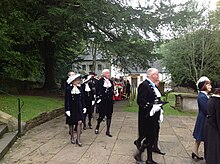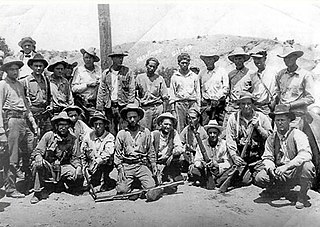England, Wales, and Northern Ireland

In England, Wales and Northern Ireland the high sheriff (or in the City of London the sheriffs) are theoretically the sovereign's judicial representative in the county,[ citation needed ] while the lord-lieutenant is the sovereign's personal and military representative. Their jurisdictions, the shrieval counties, are the ceremonial counties. The post contrasts with that of sheriff in Scotland, who is a judge sitting in a sheriff court.
The word sheriff is a contraction of the term shire reeve . The term, from the Old English scīrgerefa, designated a royal official responsible for keeping the peace (a reeve) throughout a shire or county on behalf of the king. [2] [3] The term was preserved in England notwithstanding the Norman Conquest.
English historians have offered varying estimates as to when the office of the sheriff was established. [4] According to historian George Molyneaux, "the late tenth century is a very plausible period for the introduction of sheriffs, especially in the south." [4] The office reached the height of its power under the Norman kings. While the sheriffs originally had been men of great standing at court, the 13th century saw a process whereby the office devolved on significant men within each county, usually landowners. [5] The Provisions of Oxford (1258) established a yearly tenure of office. The appointments and duties of the sheriffs in England and Wales were redefined by the Sheriffs Act 1887. [6] Under the provisions of the Local Government Act 1972, on 1 April 1974, the office previously known as sheriff was retitled high sheriff. [7]
The serving high sheriff submits a list of names of possible future high sheriffs to a tribunal which chooses three names to put to the sovereign. The nomination is made on 12 November every year and the term of office runs from 25 March, Lady Day, which was the first day of the year until 1751. No person may be appointed twice in three years unless there is no other suitable person in the county.[ citation needed ]
Nomination
The Sheriffs Act 1887 (as amended) provides that sheriffs should be nominated on 12 November (Martinmas), or the Monday following if it falls on a Sunday, by any two or more of the Chancellor of the Exchequer, the Lord President of the Council, and the Lord Chief Justice of England; other members of the Privy Council; and any two or more judges of the High Court. [8] These amendments were in 1998, the Chancellor of the Exchequer was granted full entitlement, not merely conditional entitlement, if there is no Lord High Treasurer – since the treasurership is by constitutional convention always placed into commission, and in 2006 the Lord Chancellor was removed as a nominating officer through the operation of the Constitutional Reform Act 2005. [9]
These officers nominate three candidates for each county in England and Wales (with the exception of Cornwall, Merseyside, Greater Manchester and Lancashire), which are enrolled on a parchment by the King's Remembrancer. [10]
Eligibility for nomination and appointment as high sheriff under the Sheriffs Act 1887 excludes peers of Parliament, members of the House of Commons, commissioners or officers of Her Majesty's Revenue and Customs, officers of the Post Office and officers of the Navy, Army or Royal Air Force on full pay, clergymen (whether beneficed or not) and barristers or solicitors in actual practice. [11]
Pricking
The practice of pricking is an ancient custom used to appoint the high sheriffs of England and Wales.
In February or March of each year, two parchments prepared the previous November are presented to the Sovereign (who is also Duke of Lancaster) at a meeting of the Privy Council. A further parchment is drawn up in November for Cornwall and presented to the Duke of Cornwall (or to the Sovereign when there is no such Duke). [12]
Certain eligible persons (High Court judges and the Privy Council) nominate candidates for each county shrievalty, one of whom is chosen for each by the sovereign. In practice, the first name on the list is nowadays always the one chosen; the second and third names tend to become sheriffs in succeeding years, barring incapacity or death. The Sovereign signifies assent by pricking (i.e., piercing) the document with a silver bodkin by the relevant name for each county, and signs the parchment when complete. The parchment for the Duchy of Lancaster is known as the Lites, and the ceremony of selection known as Pricking the Lites. [13] The term lites, meaning list, was once reserved for Yorkshire; [14] the date at which the name was transferred to Lancashire is unknown.[ according to whom? ] [15] The Lites is used for the three shrieval counties that fall wholly or partially within the boundaries of the historic county palatine of Lancaster, since 1 April 1974: Lancashire, Greater Manchester, and Merseyside. [13]
The practice is believed to date back to a year in the reign of Elizabeth I, when, lacking a pen, she decided to use her bodkin to mark the name instead. By contrast, Lord Campbell stated, perhaps without the intention of publication, in February 1847, "[it began] in ancient times, sir, when sovereigns did not know how to write their names." while acquiring a prick and a signature from Queen Victoria as Prince Albert asked him when the custom began. [16] [17] The High Sheriffs' Association argues pricking vellum ensured that the record could not be altered. Given that holders of the office often had to bear large costs and implement unpopular policies altering the choice of the monarch must sometimes have been tempting. [18]
Declaration
The declaration a person must make before taking the office of high sheriff is contained in the second schedule of the Sheriffs Act 1887. [19] Additional words are inserted in the case of the Duchy of Cornwall; for example, the declaration includes: "do solemnly declare that I will well and truly serve the King’s Majesty and also his Royal Highness the Duke of Cornwall". [19]
Responsibilities
Contemporary high sheriffs have few genuine responsibilities and their functions are largely representational, which include attendance at royal visits and a High Court judge opening ceremony,[ clarification needed ] proclamation of a new Sovereign, and acting as a returning officer in county constituencies during elections. [20]
Theoretical responsibilities include the well-being and protection of High Court judges, and attending them in court; and the maintenance of the loyalty of subjects to the Crown. [21] However, most of the high sheriff's work is delegated (for example, the local police now protect judges and courts) so that in effect the post of high sheriff is essentially ceremonial.
The high sheriff was traditionally responsible for the maintenance of law and order within the county, although most of these duties are now delegated to the police. [20] As a result of its close links with law and order the position is frequently awarded to people with an association with law enforcement (former police officers, lawyers, magistrates, judges). The high sheriff was originally allowed to kill suspects resisting arrest;[ citation needed ] this was still legal in the 17th century. Edward Coke noted that when the high sheriff employed constables to assist in his duties the law was also extended to them. [22]
Powers
Under the provisions of the Sheriffs Act 1887, if a sheriff finds any resistance in the execution of a writ he shall "take with him the power of the county" (known as posse comitatus), and shall go in proper person to do execution, and may arrest the resisters and commit them to prison, and every such resister shall be guilty of a misdemeanor. [23]
Exceptional counties
City of London
There are two sheriffs of the City of London, elected annually by the City of London liverymen; their function is similar, but not equivalent to that of High Sheriff, since the 1887 Act contains the saving "Nothing in this Act shall affect the privilege of the mayor, commonalty, and citizens of the city of London to elect the sheriffs of London". The sheriffs of London also served as sheriffs for Middlesex until 1889 when the office of High Sheriff of Middlesex was created. [24]
Cornwall
The Duchy of Cornwall's first charter in 1337 states that the Shrievalty of Cornwall, the right to appoint the sheriff for the county, is vested in the Duke of Cornwall. [25] Two further charters, dated 18 March 1337 and 3 January 1338, state that no sheriff of the king shall enter Cornwall to execute the king's writ.[ citation needed ] The High Sheriff of Cornwall swears to serve both the reigning monarch and Duke of Cornwall (i.e., the crown prince).[ citation needed ] When there is no Duke of Cornwall, the Duchy Council still sits, but under the trusteeship of the English (since 1707, British) monarch. Only as Duchy Trustee can the monarch appoint the Sheriff of Cornwall. Nomination and appointment generally takes place during Hilary, and announced via the Duchy of Cornwall Office. [26] [ failed verification ] [27] [28]
Durham
The High Sheriff of Durham was appointed by the Prince-Bishop of Durham until 1836, when the jurisdiction of the county palatine became vested in the Crown. [29] Since then the high sheriffs of Durham have been appointed in the same way as other high sheriffs in England and Wales. [30]
Isle of Ely
After an Act of Parliament in 1535/6 ended the palatine status of the Isle, the bishop remained custos rotulorum and appointed a chief bailiff for life to perform the functions of high sheriff within the liberty.
Lancashire
The right to nominate and select high sheriffs in Lancashire is vested in the monarch in right of the Duchy of Lancaster. [27] Before 1974, this right applied only to the High Sheriff of Lancashire, but since the administrative changes of the Local Government Act 1972 (effective 1974), the High Sheriff of Greater Manchester and High Sheriff of Merseyside also come under the jurisdiction of the Duchy of Lancaster. As with other counties in England, three names are nominated to the Chancellor of the Duchy of Lancaster for Lancashire appointments; [31] the chancellor presents these to the monarch with his recommendation in a private audience. [32] New appointments are usually announced during Hilary. [27]
London and Middlesex
| | This section needs expansion. You can help by adding to it. (October 2020) |
Wales
The nomination of sheriffs in the counties of Wales was first vested by statute in the Council of Wales and the Marches and the Welsh justices under Henry VIII. With the abolition of the Council in 1689, the power of nomination was transferred to the justices of the Court of Great Sessions in Wales. When this court was abolished in 1830, its rights were in turn transferred to the courts of King's Bench, Exchequer, and Commons Pleas. [33] Finally, by an Act of Parliament of 1845, the nomination and appointment of sheriffs in Wales was made identical to that in England. [27]








